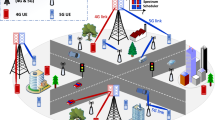Abstract
In wireless communication, licensed primary users (PUs), such as TV broadcasters, are allocated channels in the UHF and VHF spectrum for their transmission. Television white spaces (TVWS) are the unused channels, or vacant channels (VCs), which could be beneficial to unlicensed secondary users (SUs). With the TVWS wireless technology, the allocation of VC to SUs is currently based on a geolocation database (GLDB) approach. The unlicensed SUs compete for VCs as soon as they are released by the GLDB, which generates contention and long waiting times (among the SUs). Developing an efficient channel allocation strategy for the SUs, using the GLDB method, continues to be a challenge, including long waiting times. This paper discusses a methodology to minimize long waiting times by integrating a middleware sublayer, called dynamic queue regulator (DQR), into the main GLDB architecture. Under this strategy, the DQR GLDB issues a pricing scheme to the SUs in three categories: New SUs, Returning SUs, and SUs in Waiting. By coordinating with the main GLDB, the DQR middleware uses a blind ticketing cost model based on the idle times of PUs, which requires all arriving SUs to submit price offers. In this research, we simulate the dynamics of VC allocation in TVWS spectrum using two types of databases: the standard or Normal GLDB, proposed by regulators, and our DQR middleware GLDB. The simulation results show that the DQR middleware, when integrated into the main GLDB architecture, minimizes the SU waiting times by 0.3 h, or a 35.3% improvement.






Similar content being viewed by others
References
UMTS Forum Report 44 Mobile traffic forecasts 2010–2020 © UMTS Forum January 2011.
Federal Communications Commission. (2010). Second Memorandum Opinion and Order in ET Docket No. 04–186 (FCC order modifying the TVBD rules, FCC-10-174).
Federal Communications Commission. (2008). Second Report and Order and Memorandum Opinion and Order in ET Docket No. 04-186 (FCC order adopting the TVBD rules, FCC-08-260).
FCC 04-186 (2004). Unlicensed Operation in the TV Broadcast Bands, December.
Ma, S., Liu, X.-Y., Fu, L., Tian, X., Gan, X., & Wang, X. (2017). On the greedy resource occupancy threat in dynamic spectrum access. IEEE Transactions on Vehicular Technology,66, 11233–11248.
Wang, J., Zhang, Y., & Li, W. W. (2017). Strategic joining and optimal pricing in the cognitive radio system with delay-sensitive secondary users. IEEE Transactions on Cognitive Communications and Networking.,3(3), 298–312.
Dwivedi, V. K., Maharaj, B. T., & Alfa, A. S. (2016) On the queue based performance analysis of hybrid cognitive radio. In IEEE international conference on signal processing and communication (ICSC), India.
Khairullah, E. F. (2017) Queue-aware opportunistic scheduling in multi-channel dynamic spectrum access networks. In IEEE 18th international symposium on a world of wireless, mobile and multimedia networks (WoWMoM), China.
Yang, L., Cao, L., & Zheng, H. (2008). Proactive channel access in dynamic spectrum networks. Physical Communication,1(2), 103–111.
Wang, S., et al. (2010) Delay analysis for cognitive radio networks with random access: A fluid queue view. In INFOCOM, IEEE proceedings, CA, USA.
Suliman, I., & Lehtomaki, J. (2009). Queueing analysis of opportunistic access in cognitive radios. In 2009 second international workshop on cognitive radio and advanced spectrum management.
Khedun, N., & Bassoo, V. (2015) Analysis of priority queuing with multichannel in cognitive radio network. In IEEE EUROCON- international conference on computer as a tool (EUROCON).
Author information
Authors and Affiliations
Corresponding author
Additional information
Publisher's Note
Springer Nature remains neutral with regard to jurisdictional claims in published maps and institutional affiliations.
Rights and permissions
About this article
Cite this article
Atta-Boateng, G., Otoo Bobbie, P. A Geolocation Database Middleware Sublayer for Minimizing Secondary User Waiting Times in TV White Space Spectrum Allocation. Wireless Pers Commun 111, 97–109 (2020). https://doi.org/10.1007/s11277-019-06847-4
Published:
Issue Date:
DOI: https://doi.org/10.1007/s11277-019-06847-4




